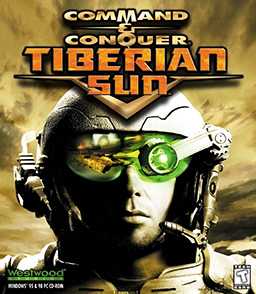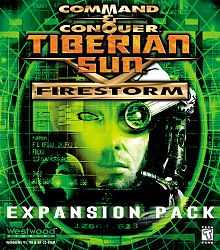Command & Conquer: Tiberian Sun
| Command & Conquer: Tiberian Sun | |
|---|---|
 | |
| Developer(s) | Westwood Studios |
| Publisher(s) | Electronic Arts |
| Producer(s) | Brett W. Sperry (Executive) Donny Miele (Senior) Rade Stojsavljevic |
| Designer(s) | Adam P. Isgreen, Brett W. Sperry, Erik Yeo (Lead) Patrick Connelly, David Leary, Michael Lightner, Patrick Pannullo, John Archer |
| Programmer(s) | Bret Ambrose, Joseph Bostic, Steve Tall (Lead) Greg Hjelstrom, Neal Kettler, Jonathan Lanier, Denzil E. Long Jr., Maria del Mar McCready Legg, Wei Shoong Teh |
| Artist(s) | Tse Cheng Lo, Eric Gooch, Jim May (3D Modelling) Paul Mudra, Dwight Okahara (Sound) Paul Mudra (Audio Direction) |
| Composer(s) | Frank Klepacki Jarrid Mendelson |
| Series | Command & Conquer |
| Platform(s) | Microsoft Windows |
| Release date(s) | August 27, 1999 |
| Genre(s) | Real-time strategy |
| Mode(s) | Single player, multiplayer |
| Distribution | Optical disc Download |
Command & Conquer: Tiberian Sun is a real-time strategy video game developed by Westwood Studios and released in 1999. The main storyline follows the second major war between the Global Defense Initiative (GDI) of the United Nations, and the global terrorist organization known as the Brotherhood of Nod. The story takes place in 2030, 30 years after the GDI had won the first major war in Command & Conquer.
As of February 12, 2010, Electronic Arts licensed Tiberian Sun and its expansion pack Firestorm as freeware.[1]
Synopsis
The plot of Tiberian Sun is a follow-up to the original game Command & Conquer, after the end of which the Nod leader Kane is presumed dead. In Tiberian Sun, Kane resurfaces from his hideout with improved military forces and new Tiberium-enhanced technologies, determined to convert the world to tiberium. The GDI commander Michael McNeil is tasked with objectives to prevent the world from falling into the hands of Nod, this time with the very means of the extraterrestrial Tiberium substance. Meanwhile, Nod general Anton Slavik must unite a splintered Brotherhood of Nod before joining Kane's fight against GDI. A third faction, Tiberium mutants, are caught in the middle of this fight and join either side, sometimes as playable and sometimes as non-playable characters.
The game consists of two separate campaigns, following McNeill or Slavik, with opposite outcomes which see Kane either triumphant or killed.
Gameplay
.gif)
The gameplay has similar principles to Tiberian Dawn but with newer and upgraded units and structures plus three new types of tiberium that can be harvested. Tiberian Sun relies heavily on science fiction technologies, and introduces a new isometric game engine featuring varying level terrain to give the impression of a true 3D environment. Dynamic lighting allows for day/night cycles and special effects, such as ion storms. Maps feature cityscapes where units could hide or battle in urban combat. Some buildings and armored units are rendered with voxels, although infantry is still rendered as sprites.[2]
During the campaign, different routes can be chosen, some of which can lead to optional missions that may affect the difficulty of the main mission, or supply the player with additional units and technologies. Tiberian Sun is the last game of the series to offer the split-route feature.
Tiberian Sun features full motion video using traditional cinematic shots, featuring well-known Hollywood actors. Michael Biehn plays GDI commander Michael McNeil, who reports to General James Solomon, played by James Earl Jones. On the side of Nod, Frank Zagarino portrays the commander Anton Slavik, who only lives to follow and enforce every thought of Kane, played by the franchise's cutscene director Joseph D. Kucan. The Forgotten are represented by Christine Steel portraying Umagon who teams up with Michael McNeil throughout their joint fight against Nod, Christopher Winfield portraying Tratos, the visionary Mutant leader, and Nils Allen Stewart portraying Mutant Commando.
Tiberian Sun features a futuristic and ambient soundtrack by Jarrid Mendelson and Frank Klepacki, who composed the signature themes for the movie sequences, as well as the game's musical score with the intention to differ from the original Command & Conquer in order to capture the mood for each mission.[3]
Development
Electronic Arts, who had acquired Westwood Studios in 1998 and published Tiberian Sun, and had no direct part in its development, pushed for Tiberian Sun's release ahead of schedule, resulting in a number of engine and gameplay features being omitted from the game, some of which were later included in Firestorm expansion pack. Subsequent games in the franchise were also heavily subjected to increased control by Electronic Arts, as well as departure of numerous Westwood personnel, eventually resulting in Westwood being closed down and assimilated.
Several images and references in the Tiberian Sun "rules" file indicate that more features were planned for the release. A former Westwood employee working for Petroglyph elaborated upon them in March and May 2007.[4] A "loadout" screen was to be implemented, allowing commanders to pick units to take into battle before missions. The "loadout" screen was finished in a prototype sequel to Tiberian Sun, codenamed Command & Conquer: Incursion, but Westwood was dissolved and Electronic Arts did not revive the concept. Drop-pods were intended to be customizable for GDI before deployment. Lighting was intended to make a huge difference for day/night play, as units spotted by light posts/towers would be susceptible to enemy fire at greater ranges, and in turn would suffer a reduction in their own range ability. Westwood planned the Hunter/Seeker Droid option to support selection of target types, but ultimately the droid was made to attack at random. Developers also didn't have enough time to finalize balanced differences in terrain types, or to make The Forgotten a full faction for the expansion, as it was initially intended.[4]
Firestorm

Command & Conquer: Tiberian Sun – Firestorm is an expansion pack to Tiberian Sun developed by Westwood and published by Electronic Arts on March 7, 2000. Firestorm also features single- and multiplayer modes.
Firestorm follows the events as they unfolded in the GDI campaign of Tiberian Sun. With Nod fractured into feuding warlords following Kane's death, Anton Slavik is determined to keep Kane's ideology alive through the resurrection of Nod's highly advanced artificial intelligence, CABAL (Computer Assisted Biologically Augmented Lifeform). The Global Defense Initiative continues its ongoing campaign to stop the spread of Tiberium and its monstrous mutations by retrieving the extraterrestrial Tacitus device, and decides to take control of CABAL to help it decode the device. In both campaigns, CABAL goes rogue and attempts to conquer the world through the systematic assimilation of human populations into cyborg armies, forcing Nod and GDI to unite temporarily against it. In the Nod ending, the defeated CABAL appears to merge with a resurrected Kane.
Reception
| Reception | ||||||||||||||||
|---|---|---|---|---|---|---|---|---|---|---|---|---|---|---|---|---|
| ||||||||||||||||
Tiberian Sun had an outstanding anticipation since the beginning of its development. It was the fastest selling game on the EA games label, selling 1.5 million copies within a month. In the German gaming magazine PC Player issue 01/2000, Tiberian Sun received a special award as "Most Hyped Game in 1999" (the year the game was released). Between 1999 and 2000, Tiberian Sun won a single Gold and three Platinum Awards from the German VUD (Verband der Unterhaltungssoftware Deutschland - Entertainment Software Association Germany) for selling more than 100,000 units (Gold) and more than three times 200,000 units (Platinum) in Germany, Austria and Switzerland. As the Gold Award is not counted into the Platinum Award, all four awards total in between 700,000 and 1,700,000 units sold. Tiberian Sun was voted #29 in PC Gamer Magazine's Readers All-Time Top 50 Games Poll in April 2000 issue.[3]
GameGenie.com rated the game 5/5, and stated:
This game is worth much more than what you pay, because if you look at everything that has been put together in this game, you'll see how truly awesome it is. My point, and bottom line, is that just about anyone can enjoy this game. They may not sit down and play it for hours on end every day like a large number of war gamers will, but they still can watch the movies and play around with the units enough that they'll have fun. I heartily recommend this game to everyone.[7]
GameSpot noted that the new soundtrack is "catchy", and stated that the game is an excellent sequel to the original Command & Conquer.[8]
Despite some of the game's technical issues resulting from its rushed release after Westwood Studios was acquired by the Electronic Arts, many reviewers considered the interactive environment, new graphics, new array of units, new concepts, single-player (story wise) and the popular multi-player to be the significant high-points of Tiberian Sun, and credited it with high rankings.[9]
Soundtrack
Frank Klepacki and Jarrid Mendelson's soundtrack was released on CD with only 16 tracks in November 9, 2005 by EA Recordings (E.A.R.S), excluding the five remaining tracks and the Firestorm tracks.[10]
- Timebomb
- Pharotek
- Lone Trooper
- Scouting
- Infrared
- Flurry
- Mutants
- Gloom
- Heroism
- Approach
- Dusk Hour
- The Defense
- Mad Rap
- Valves
- What Lurks
- Score
Fan remake
The development team of OpenRA, a project recreating Tiberian Dawn, Red Alert and Dune 2000, reported in June 2014 that recreated Tiberian Sun will be added to the project in the near future.[11]
References
- ↑ Command & Conquer: Tiberian Sun Released for Free 15/02/2012
- ↑ "Command & Conquer: Tiberian Sun Review - Gamespot.com". Gamespot. 2012-04-27.
- ↑ 3.0 3.1 "Command & Conquer: Tiberian Sun, trivia". MobyGames. 2009-07-20.
- ↑ 4.0 4.1 Adam Isgreen (2007-03-19/05-14). "Original intentions with Tiberian Sun". Petroglyph. Check date values in:
|date=(help) - ↑ "Command & Conquer: Tiberian Sun". Retrieved 2012-04-27.
- ↑ Kasavin, Greg (2009-09-01). "Command & Conquer: Tiberian Sun Review". Retrieved 2012-04-27.
- ↑ "Command & Conquer: Tiberian Sun, review". GameGenie.com.
- ↑ "Command & Conquer: Tiberian Sun, review". GameSpot. 1999-09-01.
- ↑ Command & Conquer: Tiberian Sun, press rankings at MobyGames
- ↑ "C&C Tiberian Sun (Soundtrack)". Last FM. Retrieved 10 August 2014.
- ↑ Chote, Paul (8 June 2014). "Release 20140608". OpenRA website. Retrieved 9 June 2014.
Our Tiberian Sun mod saw significant development, but will not be ready for several more months.
External links
- Command & Conquer: Tiberian Sun at the Internet Movie Database
- Command & Conquer: Tiberian Sun at MobyGames
| ||||||||||||||||||||||||||||||||||||